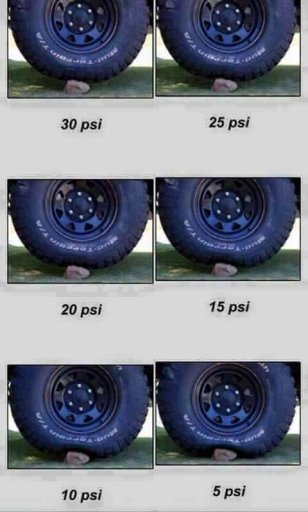
Off-Road Ranger I
- 2,865
- First Name
- Donald
- Last Name
- Diehl
- Member #
-
0745
- Ham/GMRS Callsign
- WRPN 506
well, OK, but I have found tire/vehicle manufacturers recommendations to be a bit faulty. As a young man I thought it had to do with them selling more tires as I followed their rules for a few years and was chewing through tires rather quickly. 25/30k miles at best. My latest example? The VW door sticker says 30psi, front and rear.. The front tires after only 6,000 miles were worn and choppy on the edges. I rotated them, aired up to 34 in the front and 32 in the rear.. problem solved, but each time the car went to the dealers for multiple warrenty repairs they kept airing them back down to 30. In a very light vehicle that 2-4 lb difference can make or break you. I worked away from home and didn't check their work and the tires wore out on the edges before I caught it again. I had to replace them at 30,000 miles. The next set, (same size same brand tire) still had 1/3 of tread life when we sold it at the 72,000 mile mark. Why? Manufactures recommend lower pressure for American drivers to compensate for a little harsher ride. The factory recommendation for my 80 series is only 32 lbs. really?Tire manufacturers have application guides based on weight of vehicle and other factors. For example, I'm running D rated BFG TA KO2s on a 5th gen Explorer. Standard tires suggest 32 or 36, but based on weight and the D rated tires, guide said to go 44 psi on pavement. Ride is comfortable and works great. At low to mid 30s does really well on mud and snow and ice, and can still drive on highway, but after a while you see the temperature band around edge of tires from not being properly inflated.
Proper inflation for application and rotating on a good schedule are basic tire maintenance items that really help tires last. So far I have about 40k miles on these KO2s and they still have 7-9/32 tread left.
I had E rated ST Maxx on a FZJ80. The application guide for that use said 45 psi. More if I loaded it down a of course. 70 psi on those was just too much for the LC unless I had a LOT of weight. Same tire on a suburban tow rig ran 75 psi though.
The chalk test is a good way to make sure things are right as wellx especially if you can't find the application guide :)
Sent from my HTC6545LVW using OB Talk mobile app








